
Hakea pachyphylla is a flowering plant in the family Proteaceae and is endemic to the upper Blue Mountains in New South Wales. It is a small shrub with stiff, needle-shaped leaves and clusters of yellow flowers. Formerly thought to be a Blue Mountains form of Hakea propinqua.

Acrotriche depressa, commonly known as wiry ground-berry or honeypots, is a flowering plant in the family Ericaceae. It is a small shrub with crowded greyish-green leaves and white or green flowers and grows in southern Australia.

Olearia phlogopappa commonly known as the dusty daisy-bush or alpine daisy-bush is a species of flowering plant in the family Asteraceae that is commonly found in eastern New South Wales, Victoria and Tasmania. It is a small shrub with greyish-green foliage, daisy-like flowers in white, pink or mauve that can be seen from spring to late summer.

Olearia erubescens, commonly known as moth daisy-bush or pink-tip daisy-bush, is a species of flowering plant in the family Asteraceae. It is a shrub with stiff, prickly leaves and white "daisy" flowers, growing up to 2 metres high.
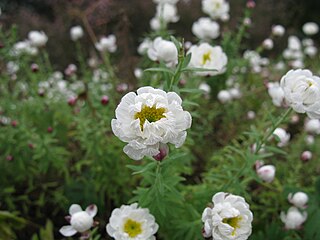
Rhodanthe anthemoides, commonly known as chamomile sunray, is a flowering plant in the family Asteraceae. It is a small, perennial shrub with greyish-green leaves, white papery flowers, yellow centre and is endemic to Australia.
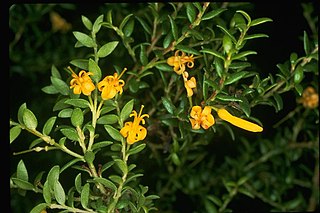
Persoonia oxycoccoides is a species of flowering plant in the family Proteaceae and is endemic to New South Wales. It is a spreading to prostrate shrub with smooth bark, hairy young branchlets, elliptic to egg-shaped leaves and yellow flowers arranged in groups of up to thirteen along a rachis that continues to grow after flowering.

Persoonia glaucescens, commonly known as the Mittagong geebung, is a species of flowering plant in the family Proteaceae and is endemic to New South Wales. It is an erect shrub with smooth bark, hairy young branchlets, lance-shaped leaves with the narrower end towards the base, and yellow flowers. It is the only persoonia in eastern Australia with strongly glaucous leaves.
Veronica brownii is a plant belonging to the family Plantaginaceae native to New South Wales in Australia, where it is restricted to the Blue Mountains. It has arching branches with variable shaped leaves and lilac flowers in spring and summer.

Trochocarpa thymifolia is a species of flowering plant from the family Ericacae and is endemic to Tasmania. It is a widespread alpine and subalpine shrub with small leaves, pink to red flowers and blue to purple fruit. Originally described by botanist Robert Brown in 1810, it is a widespread Tasmanian endemic that inhabits the state's mountain regions.

Philotheca reichenbachii is a species of flowering plant in the family Rutaceae and is endemic to New South Wales. It is a shrub with upright branchlets, crowded, linear or cylindrical leaves and pink to purple flowers arranged singly or in twos or threes on the ends of branchlets.

Veronica gracilis is a plant belonging to the family Plantaginaceae, commonly known as slender speedwell. It is a perennial herb with slender branches, variable shaped leaves and small lilac flowers in spring and summer.

Brachyscome graminea, commonly known as grass daisy, is a perennial herb in the family Asteraceae and is endemic to Australia. It has mostly mauve-pink or purple daisy-like flowers and a yellow centre.

Brachyscome dentata, commonly known as lobe-seed daisy, is a tufted perennial herb in the family Asteraceae and is endemic to Australia. It has mostly white or mauve daisy-like flowers, a yellow centre and pale green leaves. It is endemic to Australia.
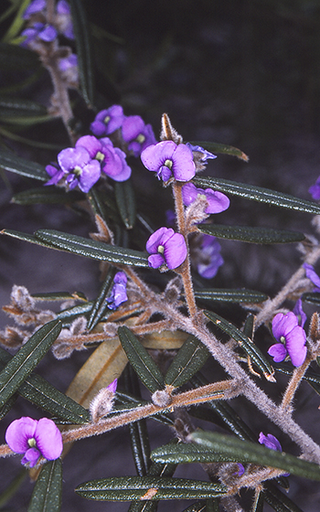
Hovea purpurea, commonly known as velvet hovea, is a flowering plant in the family Fabaceae. It is an upright shrub with narrow leaves, purple pea flowers and stems with matted hairs. It grows in New South Wales, Victoria and South Australia.

Calotis lappulacea, commonly known as the yellow burr-daisy, is a flowering plant in the family Asteraceae found in many parts of mainland Australia. It is a small, perennial herb with yellow globular flower-heads.

Streptoglossa decurrens is a species of flowering plant in the family Asteraceae. It grows in Queensland, Western Australia and the Northern Territory. It is an upright, aromatic perennial herb or shrub with pink-purplish or reddish purple flowers.
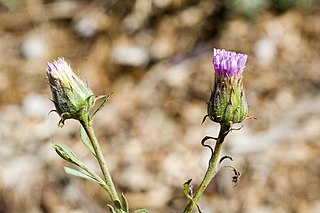
Streptoglossa liatroides is a species of flowering plant in the family Asteraceae. It is a low, spreading or upright perennial herb with pink or red to purple flowers. It grows in South Australia, New South Wales, Western Australia and the Northern Territory.

Streptoglossa odora is a species of flowering plant in the family Asteraceae. It is a spreading, perennial herb with pink or bluish-purple flowers. It grows in Queensland, Western Australia and the Northern Territory.
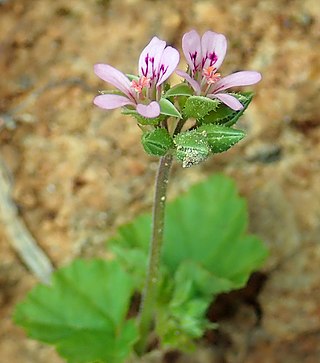
Pelargonium inodorum, commonly known as wild pelargonium, is a flowering plant in the family Geraniaceae. It is grows in New South Wales, Queensland, Tasmania, Victoria, New Zealand. It has scented leaves and mostly pink flowers.

Vittadinia muelleri, commonly known as narrow-leaf New Holland daisy, is a flowering plant in the family Asteraceae. It is a small perennial forb with bright green leaves and purple daisy-like flowers. It grows in New South Wales, Victoria, Tasmania and the Australian Capital Territory.



















